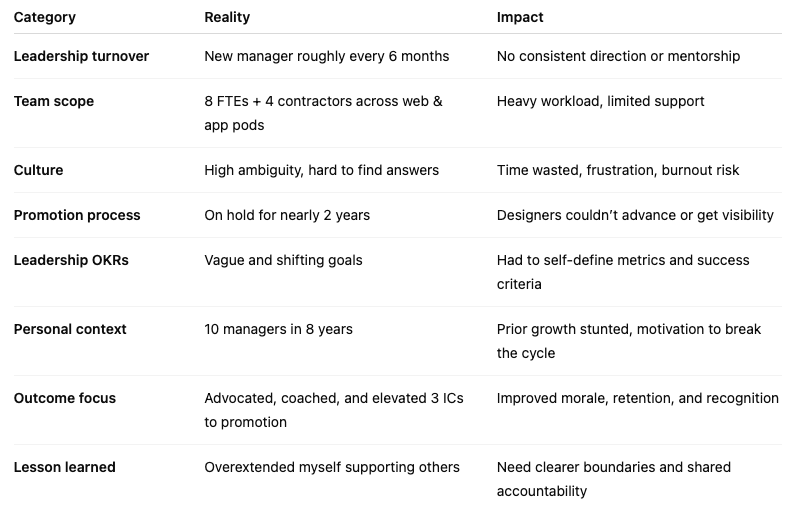Cultivating Design Leadership
Helping a team grow through instability, ambiguity, and change.
When leadership turnover and lack of structure stalled my team’s growth, I built a coaching and visibility framework to help them thrive. By introducing clarity, context-based coaching, and consistent recognition, I helped three ICs reach Senior roles, rebuilt confidence across the design org, and restored trust between design, product, and engineering.
My Role: Manager & Principal
Team: 8 FTEs + 4 contractors
Focus: Career growth, visibility, and leadership alignment
Timeline: ~6 months
Outcome: 3 promotions, multiple design awards, improved collaboration and confidence
The Challenge
When I stepped into this leadership role, the challenge wasn’t talent — it was turbulence. Leadership changed every six months, and each new manager brought new goals, new direction, and new frameworks. The constant resets left the design team without stability or space to grow.
Our team included eight full-time designers and four contractors, each responsible for their own pod across both web and app experiences. The work was complex, but the environment made it harder: information was scattered, decisions were inconsistent, and the pace of change meant most of us were reacting instead of growing.
For almost two years, there was no active promotion process. Designers were applying internally and never hearing back. It wasn’t about skill — it was about visibility and structure. Without a clear path for advancement, motivation dipped and frustration grew.
As a manager, I worked with senior leadership to set OKRs and KPIs, but those conversations rarely ended with clear targets. I often had to define success on the fly, track results independently, and surface wins upward just to show impact.
A lot of this was personal for me. I had experienced nearly ten managers in eight years, and my own growth had stalled under that turnover. I didn’t want that for my team. My goal was to make sure my ICs were supported, seen, and had a fair shot at career growth — even in an environment that didn’t make it easy.
“I had 10 managers in
8 years. The team deserved stability”
The Approach
I built a growth framework around three priorities: clarity, coaching, and visibility.
Clarity and structure
I worked with each designer to define what success looked like, project goals, career milestones, and personal development areas. Even without formal processes in place, we set quarterly goals and measured against impact, influence, and initiative.
I documented responsibilities across pods so designers could see how their work connected to business outcomes.
Coaching for growth
Weekly one-on-ones became sacred time. We talked about more than just deliverables, we focused on influence, stakeholder management, and storytelling.
I introduced “context coaching,” where we unpacked why certain challenges kept surfacing instead of just addressing the surface issue. This helped designers learn how to navigate ambiguity with confidence.
Building visibility and trust
I made sure the team’s work was seen. Designers were given opportunities to present to senior leadership, share wins across org channels, and connect directly with product and engineering partners.
When someone did great work, I amplified it. I also shared outcomes and small wins with leadership consistently — helping create momentum and visibility that led to recognition.
Over time, I started seeing confidence grow. Designers who once stayed quiet in meetings were now leading conversations and guiding product decisions. That transformation was the real success metric.
Outcomes that Matter
3
Promotions in 1 yr
25
Internal Team
Awards
in 1 yr
1
Efficient Team
in Sync
While nothing happens fast at T-Mobile, the consistent investment paid off.
One IC was promoted to Senior Product Designer after demonstrating clear growth in influence, ownership, and delivery.
Two additional ICs were later promoted into Senior roles after I advocated for and structured opportunities that aligned with their demonstrated impact.
The team earned multiple internal awards for design excellence and innovation, including one patent recognition.
I received direct feedback, appreciation emails, and recognition from both my ICs and cross-functional peers, a reflection of the trust and momentum that had been built.
Beyond the metrics, the biggest win was cultural. Designers who once felt invisible were now recognized as essential contributors. The process we created gave them clarity, purpose, and forward motion in a space that had been uncertain for years.
My Reflection
In focusing so deeply on my team’s success, I sometimes lost track of my own. I took on too much, filled too many gaps, and became the connector for everyone. It came from a place of care, I didn’t want anyone to experience the same stagnation I had, but it wasn’t sustainable.
What I’ve learned is that strong leadership also requires boundaries. Growth happens when you create space, not just for your team to rise, but for yourself to lead with balance and intention.


